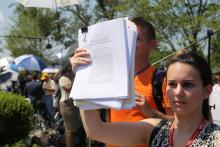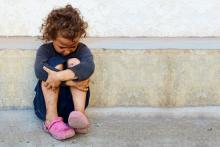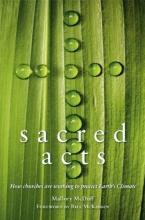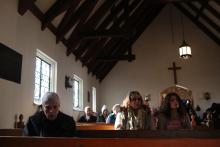Churches
ONE OF THE most well-known and revered icons today is Andrei Rublev’s reflection on the Holy Trinity, painted between 1422 and 1425 in Russia. It depicts three angels seated around a table that bears a chalice. The female figures form a circle evoking deep mutuality, interconnectedness, and love between one another. But the circle is open, inviting the world into this profound experience of community. As Christine Challiot, an Eastern Orthodox laywoman, wrote, “Rublev painted the three angels with a circular motion to signify their unity and equality, ‘thus creating a unity to represent the Holy Trinity in its movement of love.’”
This profound reflection is set in the biblical context of giving hospitality to the stranger. The icon depicts the story of the hospitality offered by Abraham and Sarah in Genesis 18:1-15 to three strangers. Abraham rushed to offer them hospitality—water and food.
The three migrating strangers are messengers of God. The text says simply that they were the Lord; interpreters see the three as the presence of the Trinity. And they, in turn, bring an announcement that Sarah, in her old age, will bear a son, fulfilling God’s promises. Sarah and Abraham suddenly find the tables reversed, and they are the guests at God’s table, being invited into this community of love. Thus, Catholic theologian Elizabeth Johnson explains, “This is a depiction of a trinitarian God capable of immense hospitality who calls the world to join the feast.”
This biblical story is a declaration of the unexpected, life-giving presence of God, discovered through providing hospitality to strangers. Rabbi Jonathan Sacks notes that the love of strangers is declared 36 times in the Hebrew scriptures, as opposed to the love of neighbor, mentioned only once. The love of strangers and sojourners is a primary test of one’s love for God; this is linked to the presence of migrating people, with whom we can unexpectedly encounter God in fresh and promising ways that open the future to new possibilities.
The most precious place on Earth for me is a camp on a lake in the Adirondack Mountains of New York. During the next century, climate change will chase northward things that I cherish. Spruce, tamaracks, sugar maples, balsam fir, moose, mink, and loons will no longer grace the shores and waters of that lake. Like most people in northern climes, I see the changes happening already. I have to fight hard against despair, for my personal losses, yes, but also for the universality and injustice of the calamity, which already affects so many of the poor and innocent.
WHY IS IT so hard for people to respond effectively to the reality of climate change?
Changing people’s minds—with facts, tables, and predictions—has proven extremely difficult. Even showing people the miraculous beauty of the planet alongside the predicted losses is not working. Guilt, anxiety, and anger can be motivating forces, but they have debilitating side effects: They are all soul-destroying.
So I wonder about our hearts. Have we ignored our emotional and spiritual connections to the planet? Could the noise swirling around climate change—science, politics, media blitzes, as well as the weather disasters themselves—drown out the voice of a loss so profound that it rests unnamed in our souls? Could our breaking hearts be part of the reason we are immobilized?
In the 1960s, Rachel Carson’s image of a “silent spring” due to the proliferation of pesticides was as heartrending as it was controversial. Carson was ridiculed, her predictions dismissed. The corporate world paid millions to have her silenced. But eventually the love of bird songs won out. People read Carson’s book, grieved at the prospect of a silent spring, spoke up, and insisted the chemical-company-supported politicians ban DDT.

In the Methodist tradition in which I was I raised, there is a concept of perfection. We “strive for perfection” in loving each other and loving God. It is not about avoiding all mistakes. It is about growing in love for neighbor and being hospitable to all we come in contact with. This is the point of our theology: as we grow in faith and love, we become closer to God. In the end, resisting God’s call to love others is pretty hard to do.
And yet we know not everyone we meet is irresistible. We all have moments when some folks are harder to love than others. Sometimes those we find difficult to love are members of our own families. Other times they are friends we’ve had a conflict with. And for some of us, they are hard to love simply because of whom the other person loves.

On a recent Monday evening, a room inside Christ Community Church was transformed into a coffeehouse with fresh-brewed coffee, plenty of popped kettle corn and the thorny subject of racism on the table.
For an hour, about 20 people gathered around tables, shared personal experiences about racism, watched a short documentary and answered questions meant to stimulate conversation.
The event is called Lifetree Cafe, and it’s a new evangelical tool gaining popularity with churches reaching out to potential members.

Jesus flips things upside down. DC 127 plans to follow suit.
The Washington, D.C.-based foster care initiative created by the District Church seeks to reverse the foster care waitlist in our nation’s capital, leaving parents waiting to foster the 3,000 children currently on the list instead of children waiting to be taken in by families.
“The heart behind DC 127 is to reflect God’s heart,” said District Church Lead Pastor Aaron Graham. “We believe there are no orphans in heaven. And Jesus taught us to pray, ‘your kingdom come, your will be done on earth as it is in heaven.’ And so our prayer is that we would reflect God’s heart, who’s adopted us, by helping adopt and foster kids in D.C.”
While many people continue to believe there is no climate crisis, those most affected by global warming—particularly in the global South—know otherwise. According to Sojourners magazine’s interview with Malawi activist Victor Mughogho, the “impacts are quite severe on the ground.”
FOR MANY IN the global South, climate change is not an abstract theory. Victor Mughogho, executive director of the Eagles Relief and Development Programme in the southeast African country of Malawi, has experienced firsthand the toll of global warming and extreme weather. He works with local churches to develop practical and faithful solutions to mitigate the effects of climate change. Sojourners assistant editor Elaina Ramsey interviewed Mughogho early last year when he visited Washington, D.C.
Elaina Ramsey: How has climate change affected the people of Malawi?
Victor Mughogho: The impacts are quite severe on the ground. Rural people in Malawi constitute about 85 percent of the population. These people are subsistence farmers. For them, rainfall is everything. Without the rain, there's no agriculture, no livelihood.
The weather patterns have changed and are so unpredictable now. In the past 20 years, official records from the government show that we've had five severe droughts. Because of the cycles of drought, there is less and less water in the ground. The water table is sinking. Trees and grass are stunting and rivers are drying up.
If you asked a person "What will happen in the next 10 or 20 years?" they'd say that what's bad now, in retrospect, is going to look like a good time. It looks like worse times are coming ahead.
Books
Faith meets science
- Scientist Katharine Hayhoe and her spouse, evangelical pastor and writer Andrew Farley, gently and wisely respond to the concerns of those who deny the reality of climate change in A Climate for Change: Global Warming Facts for Faith-Based Decisions (FaithWords). An accessible exploration of the science behind climate change and the faith-based reasons why Christians can and must act.
- Ben Lowe, of Young Evangelicals for Climate Action, describes the rise of climate leadership on Christian college campuses in Green Revolution: Coming Together to Care for Creation (IVP Books).
- In Global Warming and the Risen LORD: Christian Discipleship and Climate Change (Evangelical Environmental Network), Jim Ball offers biblical and spiritual resources needed to meet the challenge.
- No Oil in the Lamp: Fuel, Faith and the Energy Crisis (DLT Books), by Andy Mellen and Neil Hollow, is part science manual, part Bible study and points toward a Christian theology for resource depletion and "peak oil." The unexpected foreword by the CEO of a top U.K. energy company adds depth.
- God, Creation, and Climate Change: A Catholic Response to the Environmental Crisis (Orbis Books), edited by Richard W. Miller, collects original essays by leading Catholic theologians and ethicists to give theological and biblical perspectives on our environmental crisis.
- Green Discipleship: Catholic Theological Ethics and the Environment (Anselm Academic), edited by Tobias Winright, is a compendium drawing on scholars from the fields of ecology, biology, history, and sociology, and includes study group aids. It also has the text of "If You Want to Cultivate Peace, Protect Creation," a January 2010 speech by Pope Benedict XVI, which can also be found at www.vatican.va.
- Sacred Acts: How Churches are Working to Protect Earth's Climate (New Society), by Mallory McDuff, looks at local churches' best practices to reverse climate change.
NEW YORK CITY has been bombed at least twice in the past decade. First by al Qaeda and second by Hurricane Sandy.
In the wake of the Sept. 11 attacks, the United States launched two ground wars and a worldwide "war on terror." Within two months, Congress federalized the Transportation Security Administration to secure airports. More than 263 government organizations were either created or reorganized. Some 1,931 private companies were put to work on counterterrorism, homeland security, and intelligence. Rightly or wrongly, America moved heaven and earth to stop terrorism in its tracks. It was seen as both an ongoing threat and a moral affront that had to be dealt with.
What about Climate Change?
In February, a New York State Senate task force on Superstorm Sandy compared the hurricane that affected 24 states to the 9/11 terrorist attacks. "[On 9/11] there were more than 3,000 souls lost, but in terms of the geographic destruction, it was isolated to Lower Manhattan," said Sen. Andrew Lanza (R-Staten Island). "[After Sandy] we have miles and miles and miles of destruction. Hundreds of thousands of homes affected, 60 ... New Yorkers killed, 250,000 to 260,000 businesses affected."
Hurricane Sandy killed 253 people in seven countries. It was the second largest Atlantic hurricane ever recorded—and the most expensive. It smashed into the East Coast with barely three days' warning. Like hurricanes Katrina and Rita before it, Sandy was a disaster of biblical proportions.
After 9/11, Americans knew in our gut that something was seriously wrong. Our moral intuition had been sucker punched.

IN AMERICA, WE honor the ideal of equality and the myth of equal opportunity—but the secret we refuse to acknowledge is the debilitating, dehumanizing effects of poverty. As a pastor serving the South Side of Chicago, I witness firsthand the pain that poverty inflicts upon our congregation and the scars it leaves on the most vulnerable: children. Faith in Christ should mean a commitment to the poor.
There is a growing wealth gap between African-American households and white households. A Pew research study, for example, shows the dramatic change between 2005 and 2009. In 2005, the typical white household had a net worth of $134,992 (in 2009 dollars), while the typical black household had a net worth of $12,124—9 cents for each dollar the white household owned. By 2009, that fell to 5 cents, as the typical black household saw its net worth drop more than 53 percent, as compared to a drop of 16 percent for the average white household. And, alarmingly, 35 percent of black households in 2009 had a zero or negative net worth.
A few seek to blame this damaging downward trend on the current administration's policies. This is unfair and incorrect. Black families have traditionally built wealth through homeownership, but since the mid-1990s we have witnessed a dramatic increase in bank mergers—and predatory lending. Local banks, now owned by large corporate institutions with little interest in community investment, increasingly close branches in poor communities, then check-cashing establishments fill the void in financial services. At the same time, our nation faces the loss of manufacturing and the dismantling of organized labor. The triple threat of regressive economic policy, unchecked expansion of large, unaccountable financial institutions, and the economic crisis of 2008 devastated parts of cities across the nation: Chicago, Cleveland, Detroit, Atlanta, New York, Buffalo, Flint, and many others.
As Onleilove Alston reveals in “Connecting the Dots,” in the April 2013 issue of Sojourners magazine, Hurricane Sandy vividly demonstrated the relationship between climate change, poverty, and immigration. Healing is taking place as people of faith step up to coordinate recovery efforts and lead advocacy efforts to curb climate change.
To view some of the ways people are making a difference in communities affected by Hurricane Sandy, check out the slideshow below.

In the 1980s television show, “Fantasy Island,” the island watchman heralded the arrival of individuals attempting to escape their reality with a call of “the plane … the plane … the plane!”
In the weeks since the Sandy Hook tragedy, I’ve spent much of my time in Washington, D.C., preaching about our moral mandate to reduce gun violence, especially in our urban neighborhoods. However, in my time in the capital, I have come to feel as though there are many arriving in Washington on the proverbial plane, escaping the realities of their hometowns, for the Fantasy Island in the beltway.
In the Book of Proverbs, we read, “Buy the truth — don't sell it for love or money; buy wisdom, buy education, buy insight (Proverbs 23:23, The Message).”
Sadly in Washington, truth seems to be for sale; wisdom seems to be radically individualized; education seems to be mocked; and insight seems to be unable to breach the partisan walls in our nation’s capital.

The House Wednesday overwhelmingly passed a bill to allow places of worship to receive federal aid to repair their buildings damaged during Hurricane Sandy.
The bill, which garnered strong bipartisan support, is also expected to pass the Senate, and would address what its sponsors consider a discriminatory practice that keeps federal disaster money from religious groups.
Currently the Federal Emergency Management Agency excludes religious organizations but assists privately owned nonprofits. If the bill becomes law, it will make houses of worship eligible for relief on the same terms as other nonprofits.
“Today’s debate and vote is about those who are being unfairly left out and left behind,” Christopher Smith, R-N.J., one of the bill’s lead sponsors, told his House colleagues.
“It’s about those who helped feed, comfort, clothe, and shelter tens of thousands of victims now being told they are ineligible for a FEMA grant.”

IN THE FOREWORD to Sacred Acts: How Churches Are Working to Protect Earth's Climate, prolific scholar-activist Bill McKibben recalls a time not long ago when many people of faith regarded environmentalism suspiciously—conservatives saw it as a cover for possible paganism, while liberals considered it less of a priority than problems such as war and poverty. Now, however, theologians and religious leaders discuss the environment almost as much as ecologists and Nobel prize-winning scientists do. As this book shows, moreover, the environmental movement now includes religious organizations such as Earth Ministry, Interfaith Power & Light, and GreenFaith, which are working at the grassroots level in congregations and communities.
Edited by Mallory McDuff, a lay Episcopalian who teaches environmental education at Warren Wilson College near Ashville, N.C., Sacred Acts boldly focuses on climate change. McDuff believes that momentum is building among Christian communities worldwide as they call for just climate solutions—much like a modern Pentecost moment. The book addresses both skeptics and those who know climate change is real but feel overwhelmed by the problem's magnitude and despair of finding and implementing solutions.
The contributors to Sacred Acts include clergy, teachers, activists, directors of nonprofit organizations, and a farmer. Its 12 chapters are divided into four sections on the themes and strategies of stewardship, spirituality, advocacy, and justice.
Fresh Vintage
Cody ChesnuTT's Landing on a Hundred is a classic soul album, from the infectious grooves and vocals to recurrent themes of personal and social redemption (comparisons include Marvin Gaye and Curtis Mayfield). Vibration Vineyard
Reclaimed Voices
A team of actors, playwrights, and activists help Ugandan teens, many of them survivors of abduction by the Lord's Resistance Army, courageously share their stories with their community—and, through the documentary After Kony: Staging Hope, with the world. First Run Feature

NEWTOWN, Conn. — Dealing with the pain of the school shooting that claimed 28 lives will take faith, support, and joyous Christmas celebrations, church leaders said at the first Sunday services held since the tragedy.
At houses of worship around town, people gathered in pews, crying, kneeling, and hugging each other through services that focused on remembering the victims of the Sandy Hook Elementary School shooting, uniting the community, celebrating the meaning of Christmas and preventing similar disasters.
Yet even this beleaguered town's day of worship provided a moment of fear when congregants at St. Rose of Lima Roman Catholic Church fled the building, saying they were told there was a bomb threat. Police with guns drawn surrounded the church. No injuries were reported, but the church canceled all events for the day.
Earlier in the day, services at St. Rose, much like other places of worship in the area, were focused on the tragedy.

Religious groups are giving the payday lending industry a run for their money.

EVER SINCE THE apostles positioned Mary Magdalene as an “unreliable narrator” telling an “idle tale” in Jesus’ resurrection story, some men in the church have claimed maleness as normative and orthodox and femaleness as, well, not.
In the recent case of the Vatican vs. the Leadership Conference of Women Religious (LCWR), the integrity of women’s witness is, once again, called into question by male hierarchs.
These Catholic sisters represent an unbroken, cohesive expression of faith in the history of American Catholicism and in women’s presumption of equality, completeness, and active moral agency both under law and under God—a presumption that is a shining light for women around the world. The sisters might have once shared accolades for faithful servant leadership with their brother priests, bishops, and cardinals, but over the course of nearly 30 years of unfolding pedophilia scandal and blasphemous mob-like cover-up, the laity has learned to look to the sisters alone for examples of Catholic gospel witness and Christian maturity, strength, and just plain grit.
But let’s not sideline this issue as “a Catholic thing.” We don’t get off that easy. The struggle over women’s authority runs right through the denominational diaspora of the body of Christ.

SEVEN AMERICAN women sat at a long rectangular table with 10 pastors from rural communities in Eastern Congo to learn about the pastors’ work of healing and reconciliation. A brilliant World Relief translator moved seamlessly from Swahili to French to English as we jotted notes.
“When Marcel from World Relief first gathered local pastors together, we were suffering,” one pastor said. “But he reminded us that, even in circumstances like these, the church has a crucial role to play. All the victims in our communities are people given to us to care for.”
Local church pastors in the North Kivu region of Congo face personally all the sufferings common to members of their communities: murder of family members by armed militias; rape of mothers, wives, and daughters as a weapon of war; displacement from their homes because of local conflict; an economy based on subsistence farming destroyed when crops are burned or uprooted by marauding rebels.
But their personal suffering doesn’t invalidate their biblical call to “care for the least of these.” Marcel, formerly a local Congolese pastor, works with World Relief Congo to serve local pastors by providing training in leadership, community transformation, trauma healing, and conflict resolution.
The pastors’ first challenge was to create committees representing every denomination and tribe in the region. The committees meet monthly to determine who in the community is most in need—a family with nothing to eat, a widow without shelter, a victim of sexual assault who needs hospital care. Sometimes the most needy are church members; sometimes they aren’t. It doesn’t matter.
JUST OVER A year ago, I attended a retreat sponsored by the Fund for Theological Education. During the retreat we were encouraged to look at our lives and to find a personal story that captured the essence of what led us to our particular ministries. That led me to reflect on my childhood: growing up in poverty, attending a different school every year, walking to school with cardboard in the bottom of my shoes because the soles were worn out, wondering how I was going to eat, lacking school supplies at times, and dealing with the stress of a single mother who was a substance abuser.
By reminding me of those things I endured and had to overcome as a child, that exercise helped me tap into my real passion. I wanted to find ways to help children growing up in similar circumstances. I wanted to inspire them to believe in themselves and know that they can make it.
At-risk youth and under-performing students need to be inspired, but equally important is their need for adults who are willing to do the work of helping them succeed academically. Education continues to be our most reliable tool for creating upward life trajectories and optimal opportunities. Churches are more than places where people come in search of a deeper relationship with God; they are also places where people come to find deeper connections with their communities and the possibility of using their gifts and talents to help those in need.
All these forces together compelled me to act on an idea I had more than a year ago: to call on friends from across the country to help create Faith for Change. Faith for Change builds a national network of churches and people of faith committed to implementing proven educational strategies for improving children’s lives.